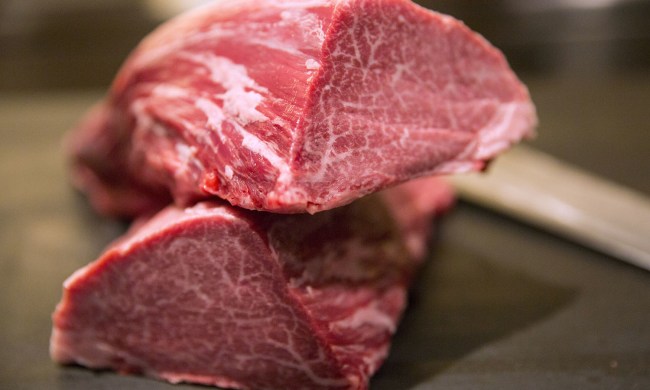
Are you searching for a sexy Valentine’s date night recipe to make at home? Impress your partner and your palate with a thick, juicy côte de boeuf.
Côte de boeuf is just a fancy French word for a bone-in ribeye steak, so don’t be intimidated by cooking this glorious hunk of meat. To make things even easier for you, we turned to Jordan Terry for some expert advice. Terry is the executive chef at Major Food Group’s Dirty French, a lively bistro that infuses classic dishes with contemporary techniques and bold flavors. The côte de boeuf is one of the most popular menu items at the restaurant, and it’s actually quite simple to make at home — all you need are a few ingredients, some time, and a carnivorous appetite. Here, chef Terry walks us through all the necessary steps and tells us how to prepare a salad and potatoes to go with the dish.

Côte de Boeuf Recipe
Ingredients:
- 1 Côte de Boeuf (bone-in ribeye) 30-40oz, 2-3 inches thick
- 1 pound butter
- 2 bunches thyme
- 1 bunch rosemary
- 1 head garlic
- Kosher salt
- Black pepper
- Canola oil
Method:
Note: A 12-inch cast iron is a great pan and perfect for this.
- To season, lay the CDB on a large tray and grind black pepper on it until your arm is tired, then keep going. Take a break and cover the CDB with kosher salt. Sprinkle some oil over it and keep raining down salt, which will help form the crust.
- Place the pan on high heat until it is ripping hot, about five minutes, and douse with oil to cover the bottom at least a quarter inch. A smoking pan is a good indicator that the pan is ready. Quickly lay in the CDB to get an initial char.
- After a minute or two, flip the CDB. Sear this side on high heat for another minute or so. Keep flipping the CDB every one to two minutes, slowly building the sear. Each side gets high heat for a bit, then a bit of relief. This allows the heat to enter the meat more slowly and evenly, avoiding the “bullseye” of temperatures in this thick cut of beef and giving more control over the final temperature. This process can take a solid 10-20 minutes of cooking, depending on the CDB and heat source. Use a meat thermometer and cook it until the CDB is about 105-110 degrees in the pan.
- Once the CDB’s temperature is in the rare cooked zone, carefully pour out the oil from the pan into a heat-safe container. Then add a large spoonful of butter, a bunch of thyme, a few sprigs of rosemary, a few cloves of crushed garlic, and another pinch of salt. Begin basting the butter and aromatics over the steak until the butter is super foamy and starting to brown.
- Then place the herbs on a tray and lay the CDB, along with the butter, on top of them to rest (the herbs elevate the steak so it’s not sitting in its own juices, which could diminish the crust). This step cannot be skipped. It is part of the cooking process. Just set it aside, drink some wine, wipe down the oil on the stove and relax. Allow the CDB to rest for a solid 10-20 minutes, at least as long as the cooking time, until it reaches body temperature. It is now ready to serve.
- Ideally, the potatoes were cooked earlier and are someplace warm nearby, and the salad can be dressed and set on the table. As a final step, take the wiped-out pan and place it back over high heat for a minute or so, and add another big spoon of butter, thyme, rosemary, and salt until it is foamy and aromatic. Add the well-rested CDB to the butter, searing it on each side and basting again to warm it up slightly.
- Remove the CDB from the pan to a cutting board. Slice it into half-inch thick slices. If everything has gone to plan, there should be some evenly rosy pieces with a beautiful dark crust on each side. Place the slices on a large platter, pour a bit of the pan drippings on top, pour some more wine, and enjoy. Don’t forget the old restaurant adage that the key to a good steak is a good steak knife. If you’re gonna splurge, you gotta splurge.
Side Dishes
Simple Salad
This is a favorite simple salad of various greens — little gem, bib lettuce, arugula, iceberg, kale, or whatever greens are preferred. It should be dressed very simply with a squeeze of lemon juice and a small glug of olive oil. Another alternative is some mustard, vinegar, and olive oil.
Pomme Purée
Dirty French serves theirs in the style of Joel Robuchon’s Pomme Purée, which is essentially equal parts potatoes and butter. It is a recipe that takes a lot of tools and practice, and even then, we still mess it up and make a mess. So really, just make your favorite mashed potatoes. In a pinch, Popeyes will deliver a fine version to pass off as your own.












